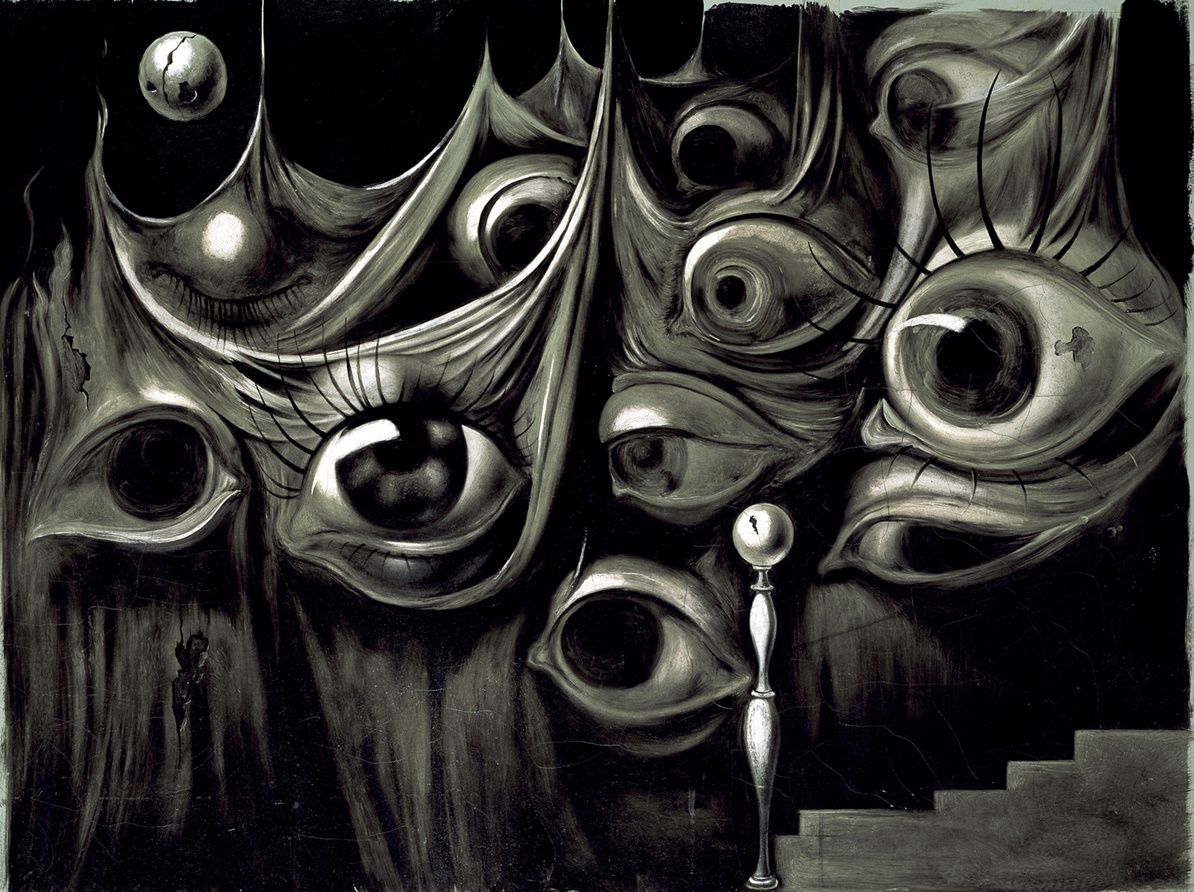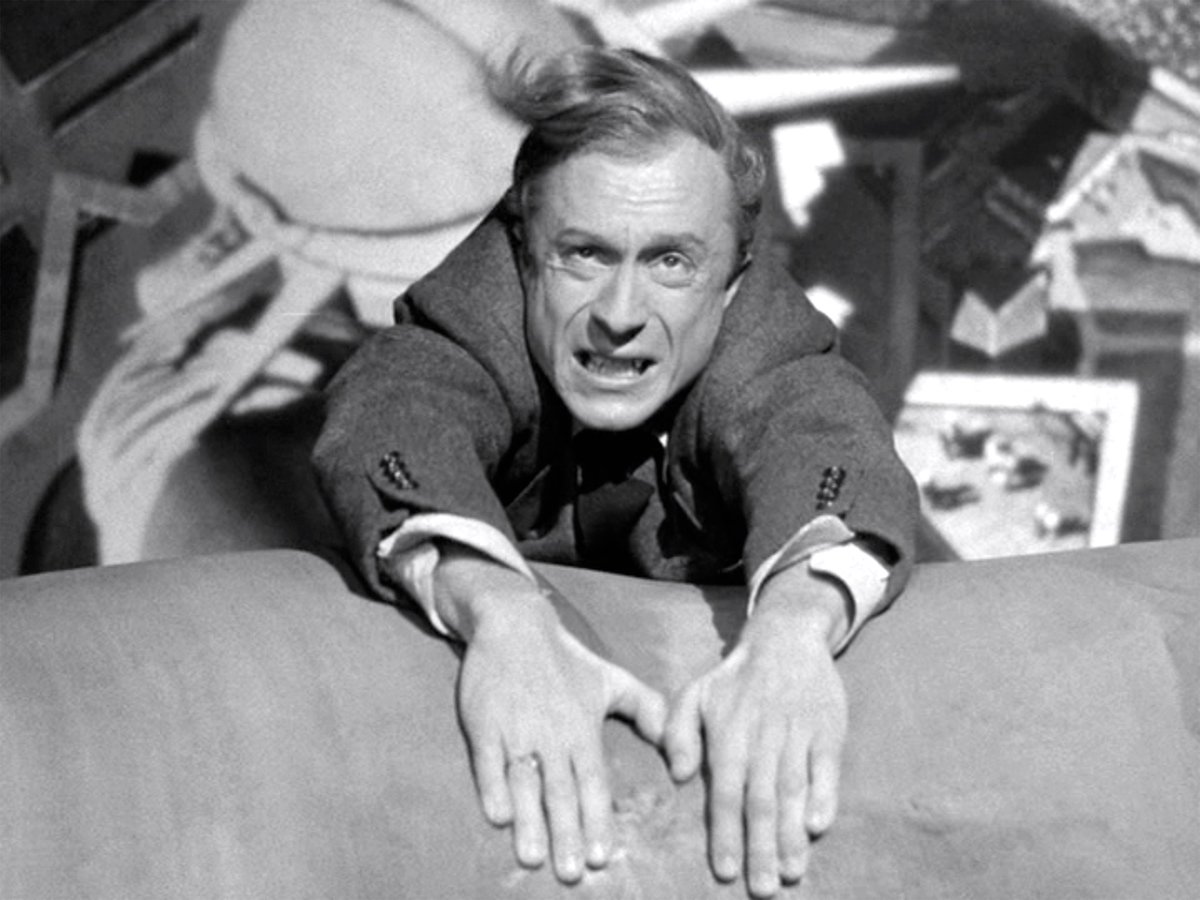Five decades ago, a fan picked up a set of the director’s meticulous storyboards for just $50 – including the lost Spellbound dream sequence by Salvador Dalí in which Ingrid Bergman turns into ants
by Tim Jonze
It is Los Angeles in the early 1970s and the critic John Russell Taylor is driving around the San Fernando Valley, checking out the goods on offer at various yard sales. It’s usual for locals to put their bric-a-brac out on their lawns, hoping to raise some cash. What’s less usual, however, is the bounty that Taylor spots in one yard: a series of storyboard panels from Alfred Hitchcock’s 1945 film Spellbound, a thriller about a psychoanalyst starring Ingrid Bergman and Gregory Peck.
Taylor recognises them straight away. He is a Hitchcock scholar, who will go on to write the director’s authorised biography. On closer inspection, he notices something else: that one of the panels depicts the film’s famous dream sequence, and seems to have been drawn by a different artist to the others; a world-renowned surrealist who was hired when the sequence was first conceived as a 20-minute showstopper rather than the three-minute segment it ultimately became. Among the stack of nine storyboard drawings Taylor purchased that day, he walked away with one that was most likely drawn by Salvador Dalí himself.
“I can’t remember how much I paid, but I think it was $50 for the lot,” says Taylor when I meet him at his home, an unassuming terraced house in London suburbia that reveals a cornucopia of artworks once you step inside. The nine Hitchcock panels are on display proudly above the fireplace in the living room, with the Dalí one taking centre stage.
At the time he made the purchase, Taylor was meeting Hitchcock for lunch on a weekly basis. He says the director assured him it must be an original Dalí, recalling how the surrealist had hastily corrected some of the angles using watercolours. Hitchcock also confirmed that the other storyboards were from a series created by art director James Basevi, who was brought in to condense Dalí’s ambitious vision into something more traditional (and certainly more affordable to film). “You can actually see some of Hitch’s sketches in the margins,” Taylor points out as he shows me the panels.
The story of the director and his storyboards is a fascinating one, as told in the new book Alfred Hitchcock Storyboards by Tony Lee Moral, who is also at Taylor’s house today. While other directors might sketch very rough scenes as a guide to their films (or not bother with them at all), Hitchcock was fastidious, creating meticulously drawn pictures that could be translated, almost Xerox-like, to the screen. In fact, Hitchcock would sometimes claim that storyboarding was his main creative duty, and that he regarded the directing process as mere donkey work, so dull that he barely bothered looking into the viewfinder.
“He always claimed that anyone could have directed his films,” laughs Taylor. “Because he’d got it all arranged in his mind beforehand.” He recalls the first time they met, in London in 1972, when Hitchcock was shooting a river scene for Frenzy. “It was the freezing midwinter and Hitch said, ‘If it gets any colder I will just phone it in.’ Of course it’s not true that anyone could have stepped in and directed. I saw him several times adding and changing things around while he was shooting. But that’s what he liked to claim, anyway.”
Detailed storyboarding also helped Hitchcock avoid something he loathed: cliche. When he made Shadow of a Doubt, he was keen to drag his film noir away from the stereotypes of dark alleyways and lurking strangers, so his storyboards reflected a radical use of light and shade. The sketches for Vertigo, meanwhile, show the action taking place from the character’s viewpoint, from a perspective so difficult to capture on camera that Hitchcock had to create a new lens effect specifically for it.
His aversion to cliche was on full display in Spellbound’s dream sequence, which was central to the movie’s plot. While other directors liked to rub Vaseline on the camera lens to create hazy nocturnal visions, Hitchcock strived for something as bright and clear as our most vivid dreams. To attain it, he paid Dalí the princely sum of $4,000 to design a unique centrepiece for the film.
“Hitch was savvy,” says Moral. “He knew Dalí was a huge name to market the film with.” And Dalí jumped at the chance, having been desperate to get into Hollywood. He had already made a couple of art films with Luis Buñuel, (Un Chien Andalou and L’Age d’Or), when he was commissioned for Spellbound, and he started work on Destino shortly afterwards, an animated short for Disney that was eventually released in 2003.
The problem was that Dalí’s ideas for Spellbound were a little too unique. Among other things, his storyboards involved Bergman turning into a statue that would then break up into ants. “It was basically unfilmable,” says Moral.
That was certainly the opinion of producer David O Selznick, who became so concerned about the costs that he considered scrapping the film altogether. In the end he asked Basevi to make a more pragmatic version, still based around Dalí’s sketches. “I would say Dalí played a big role in the finished sequence, but at some distance,” says Taylor.
The artist may have been disappointed – his credit ultimately read: “Dream sequence based on designs by Salvador Dalí” – but the finished film certainly fulfilled Hitchcock’s vision for a dazzling sequence.
Taylor was living and teaching in LA when his friendship with Hitchcock blossomed. In fact Hitchcock’s personal assistant Peggy Robertson once told Taylor that Hitchcock viewed him as the son he never had. “I was the right age and I was British,” says Taylor. “And as Cary Grant once said to me, at least I knew what Liquorice Allsorts were!”
Taylor recalls the practical jokes that Hitchcock gained a reputation for playing: the time he brought a live horse into his actor friend Gerald du Maurier’s dressing room, for instance. “They were fantastic rather than cruel,” he says. Although I’m not sure you could say that about the time Hitchcock handcuffed one of his film technicians in the studio overnight, having secretly fed him laxatives before he left for the evening. “It doesn’t sound like the nicest joke, he did shit himself during the night,” accepts Taylor. “But I did talk to people who worked on that film who said they didn’t like the person and it served them right.”
Hitchcock, of course, had a reputation with a darker aspect than mere pranks. In her 2016 memoir, Tippi Hedren claimed that the director sexually assaulted her while she worked on The Birds and Marnie.
According to Taylor, Hitchcock described himself as “the shyest, most timid man in the world”, someone who would eat dinner with his family in a special enclave at restaurants so as not to be noticed. He also had a cynical outlook on friendship, jokingly telling Taylor on one occasion that he only had two friends: “One of them is the meanest man in the world, and the other would stab me in the back as soon as look at me.” Nearly all of Hitchcock’s close relationships were with women, notes Taylor, “so I think I had an advantage there”.
One thing he is adamant about is that Hitchcock was a true one-off. He tells me that it was conventional for a director to film a scene several times – a long shot, a closeup and a medium closeup, so the producer had various options for editing. But Hitchcock hated anyone interfering with his films. Maybe that’s another reason why he relied so heavily on his storyboards: it meant that he could capture exactly what he wanted and nothing more. That way, even an interfering producer such as Selznick would struggle to meddle too much with the finished result.
“He always found ways of exerting total control over his films,” says Taylor. “He was no fool, was Hitchcock.”
Alfred Hitchcock Storyboards by Tony Lee Moral is published by Titan books, priced £34.99
The Guardian, March 26, 2024


